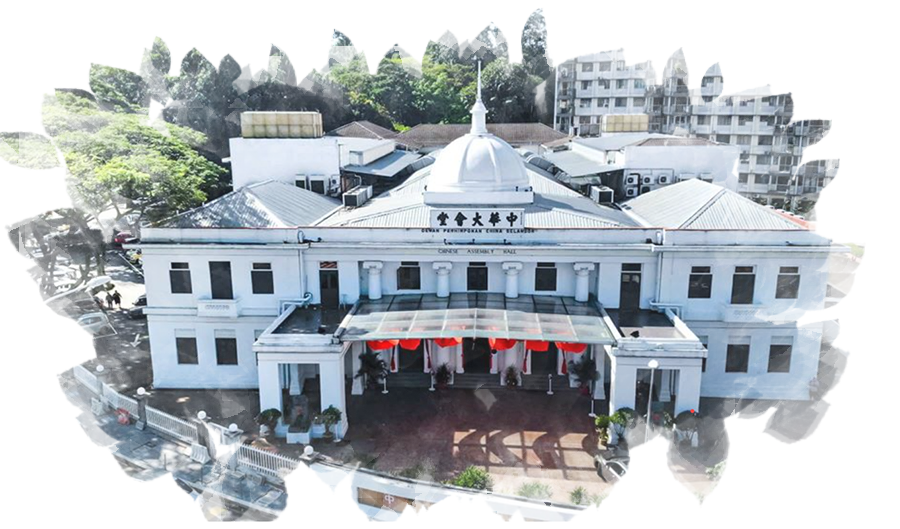The Engchoon Kuala Lumpur History Gallery






The Kuala Lumpur and Selangor
Chinese Assembly Hall
Taking on the Major Task of
Fundraising During the Most Difficult Times
The idea of establishing the Selangor Chinese Assembly Hall, the highest organization for Chinese in Selangor, was proposed in the 1910s, initiated by prominent miners such as Loke Yew, Cheong Yoke Choy, and Choong Yik Phin. Loke Yew was the first to pledge 50,000 dollars. Concurrently, Kapitan Yap Kwan Seng applied for a plot of land from the government. On August 23, 1923, in response to calls from Choong Yik Phin, Cheong Yoke Choy, Lau Leng Yen, and Loke Wan Tho, the Selangor Miners Association and the Selangor Chinese Chamber of Commerce, along with representatives from other societies and regional associations, convened a Chinese assembly at the Selangor Miners Association. This led to the birth of the Selangor Chinese Assembly Hall, which bridged the Chinese communities in Selangor and Kuala Lumpur across various industries, dialects, and regions.
During the founding phase of the Selangor Chinese Assembly Hall, although the Engchoon community was not part of the core leadership, they continuously assisted in the organization of Selangor Chinese Assembly Hall. In the second Chinese assembly, a committee of twenty-five members was elected for fundraising. Within just three months, the two chairmen of the committee resigned consecutively. During this challenging period, Huang Chongji and Ang Chin Chong from the Kuala Lumpur Engchoon Association took on the crucial task of fundraising, successively leading the fundraising committee.
In 1935, among the board of directors elected by the Selangor Chinese Assembly Hall are, Huang Chongji, served as the Deputy President (currently Vice President), and Chan Yam Chun as executive director. After that, many activities were initiated by the Selangor Chinese Assembly Hall such as the formation of the “Selangor Overseas Chinese Aid British Committee” during World War II, where nine out of the sixty-three members were from the Engchoon community.
Wong Chong Kit leads the fundraising committee
Source: Provided by Kuala Lumpur Eng Choon Hoey Kuan

Ang Chin Chong leads the fundraising committee
Source: Provided by Kuala Lumpur Eng Choon Hoey Kuan

In the 1970s, the influence of the Engchoon community in the Selangor Chinese Assembly Hall reached its peak. Li Yannian who began serving as the Vice President of the Assembly Hall in 1963, held the position of President from 1975 to 1982. His successor, Qiu Xiangchi, also from the Kuala Lumpur Engchoon Association. During Li Yannian’s tenure as President, Engchoon members like Ngau Mau Tong and Teh Tie held significant treasury positions within the Assembly Hall.
Li Yannian’s most notable contribution as President of the Selangor Chinese Assembly Hall was opening the doors to a broad range of members, revitalizing the organization’s vitality. One month into his presidency, he initiated reforms aimed at uniting Chinese associations across Selangor. By 1981, the membership of the assembly hall had surged from the original 22 units to 197 units. This measure addressed the long-standing challenge of low levels of the assembly hall member since inception, thereby problems faced to stay in its operations.
Under Li Yannian’s leadership, the network between the assembly hall and the Chinese community was significantly strengthened and expanded. This facilitated his successor, Qiu Xiangchi, in promoting the assembly hall’s affairs. Before becoming President, Qiu Xiangchi, originally from Mayang Village, Engchoon County, had served as the Director of Culture and Education, where he successfully enhanced the Assembly Hall’s cultural and educational activities.
Li Yannian
Source: Provided by Kuala Lumpur Eng Choon Hoey Kuan

Qiu Xiangchi
Source: Provided by Kuala Lumpur Eng Choon Hoey Kuan

The greatest accomplishment of Qiu Xiangchi during his tenure was leading the fifteen Chinese organizations to present the “National Cultural Memorandum” to the government and successfully organizing the Chinese Cultural Congress. This not only sparked a surge of cultural activities within Chinese organizations but also fostered closer collaboration with national Chinese associations. Regular joint meetings were held to address issues within the Chinese community, which led to the emergence of the “Fifteen Chinese Organizations” as a significant representative body in the history of Malaysian Chinese association. The Fifteen Chinese Organizations later evolved into the Federation of Chinese Associations Malaysia (FCAM) during Lim Yuk Jing’s era in the 1990s. This top leadership organization of Malaysian Chinese associations was renamed as Huazong (Federation of Chinese Associations Malaysia) in 1997. The current Huazong President, Phang Tian Seng, and the Secretary-General, Dr. Chua Wee Hian, their ancestral places are Engchoon, Fujian.
In 1992, during Lim Yuk Jing’s presidency, Ngau Mau Tong served as Vice President, and Yew Pui Seng and Tan Tat Chan served as directors. From 1998 to 2000, Chua Cheng Mun and Teh Fook Seng concurrently held the position of Vice President. Chua Cheng Mun, a lawyer by profession, continued as Vice President until 2009 before transitioning to the role of Legal Advisor. From its founding and growth to its organizational reforms in the last century, the Engchoon community has been actively involved in the activities of the Selangor Chinese Assembly Hall.
Controversy over the Abolition
of Permanent Directors
of the Selangor Chinese Assembly Hall
During the construction of the Selangor Chinese Assembly Hall (SCAH), there was an economic depression, the prices of local products fell, and the market was sluggish. The fundraising results were far below the expected targets. To prevent the construction from halting due to financial difficulties, SCAH convened a second conference of overseas Chinese to discuss countermeasures. It was decided that various associations and guilds in Kuala Lumpur would serve as permanent directors to strengthen SCAH and organize a large-scale fundraising campaign. The term “permanent director” appeared for the first time in SCAH documents. In short, “permanent directors” emerged from a specific historical context, laying the social foundation of SCAH.
The historical origins of the “permanent directors” in SCAH stem from a controversy over the naming of the grand hall, which led to the resignation of individual directors. To prevent a lack individual directors, 22 groups were invited to serve as permanent directors. Apart from 17 guild organizations and three industry-related organizations, Renjingshe and Zuele Drama Societies were also invited due to their relentless efforts in raising construction funds for SCAH. In summary, the emergence of the 22 permanent directors was a result of historical circumstances, not a product of their active pursuit or a specially designed system. The leaders of the Engchoon Guild in Kuala Lumpur were invited to become permanent directors because they took on the heavy responsibility of the fundraising committee during the controversy over the hall’s name and the resultant difficulty in raising construction funds.
The issue of “permanent directors” arose mainly due to changes in the Chinese community in the Selangor and Kuala Lumpur regions. With the growth of the Chinese population and the increase in Chinese organizations, the membership structure of the Selangor Chinese Assembly Hall (SCAH) also needed to be adjusted. After 1975, under the leadership of Li Yannian, SCAH’s organizational culture began to transform. With an open-door policy, SCAH’s membership expanded from the original 22 Chinese organizations to 197. Although this expansion broadened SCAH’s social foundation, it also intensified the later controversy over whether to abolish the permanent director status during leadership re-elections.
At the 1986 General Assembly, the Selangor Peng Clan Association once again proposed to review the automatic director status of the 22 permanent members. However, this proposal was not passed due to non-compliance with the procedures for amending the constitution. Nonetheless, another related proposal by Peng Gumeng, a representative of the Selangor Peng Clan Association, was approved: “This General Assembly authorizes the next Board of Directors to amend the constitution of the association and its non-profit limited company, to study the clause regarding the automatic directorship of the 22 permanent members, and to establish a new regulation stipulating that all directors be elected by the General Assembly to conform to the spirit of democracy.” At the first meeting of the 23rd Board of Directors on May 24 of the same year, a nine-member committee was established to amend the constitution. It was decided that before any amendments, the opinions of the 22 permanent members must be sought. Furthermore, any suggestions from the committee had to be discussed by the Board of Directors before a decision was made. On March 11, 1987, the resolution received a joint opposition from 20 of the 22 permanent members (automatic directors), firmly against abolishing the automatic directorship of the 22 members. Clearly, during this period, directors from different camps were competing over the issue of permanent directors.
On April 26, 1999, SCAH held an extraordinary general meeting and passed the proposal to abolish the permanent directors with 155 votes to 29 votes. From then on, the “permanent director” became a historical term. However, Li Shantu, a representative of Renjingshe, took the matter to court in an attempt to retain the status of the 22 permanent directors, but the court rejected the application. In response, Liu Panshi, president of the Selangor Chinese General Chamber of Commerce, one of the groups represented among the permanent directors, established the Kuala Lumpur Chinese Assembly Hall. This action forced SCAH to rename itself the Kuala Lumpur and Selangor Chinese Assembly Hall (KLSCAH), to prevent a split and confusion regarding the highest representative body for Chinese affairs in Selangor and Kuala Lumpur.
Although it took over a decade of debate to abolish the permanent directors, we cannot ignore the contributions of these 22 Chinese organizations in stabilizing the foundation of SCAH in its early days. Initially, the permanent director position was created to stabilize the leadership and prevent a leadership vacuum caused by directors resigning over the hall naming controversy. This was a product of historical conditions. The status of permanent directors was not meant to be immutable and needed to be reviewed in response to changes in social environment and organizational growth. Whether to partially retain or completely abolish it often depended on human factors rather than being handled solely from the perspective of historical contributions.
From the historical development of the Chinese community in Kuala Lumpur, the Engchoon people have always held significant positions in major Chinese organizations. From the early days of the Selangor Chinese Assembly Hall’s (SCAH) establishment, Engchoon people played key roles in the fundraising committee. After independence, Engchoon people began to enter the core leadership of Kuala Lumpur and Selangor. Li Yannian simultaneously served as president or held important positions in the Kuala Lumpur Engchoon Association, Selangor Hokkien Association, Yong Lian Association, Malaysian Hokkien Federation, Kuala Lumpur and Selangor Chinese Chamber of Commerce, Malaysian Chinese Chamber of Commerce, and SCAH. It is not an exaggeration to say that the Malaysian Chinese community entered the Li Yannian era in the 1970s. During this period, the core leadership of the Kuala Lumpur Engchoon community also reached the pinnacle of the Malaysian Chinese community. Following Li Yannian, Qiu Xiangchi and Lin Yuqing also led SCAH. Later, Lin Yuqing served as the leader of the top Chinese organization, the Federation of Chinese Associations Malaysia, the predecessor of the Malaysian Chinese Association .
Chinese organizations need to adjust their pace in response to the current development. The controversy over the 22 permanent directors of SCAH took many years to resolve. During this controversy period, the Kuala Lumpur Engchoon Association, as a permanent director, had already expressed its own position. Although the status of permanent directors was abolished, the Kuala Lumpur Engchoon Association did not withdraw from SCAH, demonstrating its respect for the spirit of democracy.

